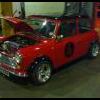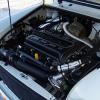head gasket
#1

Posted 13 May 2007 - 10:42 AM
hope someone out there can help me?
i have just changed my haed gasket on my 1275 spi i have not driven the car YET, but have just been told that i need to get the engine temperture up then go round and tighten it up again , but to what touge set to this time?
hope someone can help cheers Daz
#2

Posted 13 May 2007 - 11:15 AM
#3

Posted 13 May 2007 - 12:30 PM
#4

Posted 13 May 2007 - 01:43 PM
#5

Posted 13 May 2007 - 02:57 PM
#6

Posted 13 May 2007 - 03:04 PM
Don't crack them back unless you use ARP (that right) bolts, as they stretch so you torque them 3 times.
????????.........
The A series engine does not use stretch bolts.
You need to 'crack' (I dont think its an apropriate word, but as its being used) the nuts off so that when you tighten them you will not over do the torque. 1/4 of a turn loose is more than enough, then re torque.
ARP bolts do not streach any where near as much as the standard bolts, thats the point. When ARP talk about streach, its to do with the torque applied giving a set clamping load at a certain amount of bolt streach, usualy relating to the big end bolts. The standard bolts can be used almost indefinately, as long as they show now signs of damage, they will be fine in all but high performance engines
#7

Posted 13 May 2007 - 03:26 PM
The A series engine does not use stretch bolts.
You need to 'crack' (I dont think its an apropriate word, but as its being used) the nuts off so that when you tighten them you will not over do the torque. 1/4 of a turn loose is more than enough, then re torque.
Riight, I'm using the mini builder engine DVD as a reference. They use ARP head studs which they torque and un-torque 3 times. Or (as the bloke says) you can torques them or use a stretch gauge.
Sorry about my crude terminology. This is why people don't work with me. I use words as "thingy-me-bob" and "wha-ga-ma-ding-dong".
How the hell I thro an engginner course I have no idea.
#8

Posted 13 May 2007 - 04:02 PM
Stretch is another method of tightening the fastener, torquing is and other as is torque angle (the number of turns tightened to achive the desired clamping force)
Wasnt having a go bud, its better to understand why things are done rather than accept things without knowing why
Oh and it was Dan who used the 'crack' terminoligy first
Edited by Mini Sprocket, 13 May 2007 - 04:05 PM.
#9

Posted 13 May 2007 - 04:14 PM
That sounds like something only half understood by the engine builder, either that or you haven't understood it fully Adam. Read some of the articles on the ARP site about torque loading bolts. For one thing you can't use a stretch gauge on a blind stud like a head stud. They are refering to cycling new studs. When you tighten a bolt you are essentially pre-loading it by stretching the bolt slightly, meaning it is pulling and so resisting the force tyring to seperate whatever it is holding together. Using a torque wrench, the figure you see developed as torque is generated by friction between the fastener and what it is threading into. If you had a good enought lubricant you would never really generate any torque and simply keep stretching the bolt 'till it broke. New fasteners have rough, brand new surfaces on a microscopic level so there is a lot of friction present. ARP tell you to cycle new bolts and nuts essentially to grind them in and remove this roughness before finally torqueing them up, that way you will get a more reliable torque reading and most importantly all the fasteners holding a specific component will be better matched so the clamping load will be more even. You should do this with all new critical nuts and bolts, whoever makes them. It's just good engineering practise. Incidentally they now recomend 5 cycles rather than 3. In theory, after 5 cycles all the surfaces should be smooth and so the torque you are reading is generated purely by the stretch in the bolt pulling the threads into each other and not by the rough surface. With old, used fasteners however this has already been done. The section of thread inside the nut will never get rusted up, so long as the surface is undamaged once they are worn in they should always torque to the same level.
ARP technical
(Sprocket beat me to it!)
Edited by Dan, 13 May 2007 - 04:15 PM.
#10

Posted 13 May 2007 - 04:39 PM
Wasnt having a go bud, its better to understand why things are done rather than accept things without knowing why
Thats alright man.
I personally have some suspicions about the people who made that DVD. Little gems like this are always cropping up from it.
Think most of them "gems" are from me.
#11

Posted 13 May 2007 - 08:34 PM
#12

Posted 14 May 2007 - 02:45 AM
I was instructed by several people that Keith Calver recommends a slightly different initial torque procedure when using the black Payen gaskets. His method is to build up the engine and torque the head studs as normal, fill the engine with oil but NOT coolant. The next step is to start the engine without coolant and keep your hand on the cylinder head. As soon as you feel the head getting warm you switch the engine off and re-torque the head. The explanation given for this was that it allows the coating on the Payen gasket to soften and then adhere better to the block and head. When I rebuilt my car's engine I didn't have the nerve to try it. It goes against everything I've done on other engines. Has anyone else heard of this method?
#13

Posted 14 May 2007 - 07:06 AM
Back on the subject of head gaskets, I have a question for those of you who have worked on rebuilding more A-series engines than I have.
I was instructed by several people that Keith Calver recommends a slightly different initial torque procedure when using the black Payen gaskets. His method is to build up the engine and torque the head studs as normal, fill the engine with oil but NOT coolant. The next step is to start the engine without coolant and keep your hand on the cylinder head. As soon as you feel the head getting warm you switch the engine off and re-torque the head. The explanation given for this was that it allows the coating on the Payen gasket to soften and then adhere better to the block and head. When I rebuilt my car's engine I didn't have the nerve to try it. It goes against everything I've done on other engines. Has anyone else heard of this method?
Yes I heard the same thing, I replaced my head at Christmas, for a recon'd 12G295 which had been skimmed and rebuilt. I removed the old head and replaced it. Since then I have had problems with it weeping water from the left had side and oil from the right.
I removed the gasket and changed it for a copper, same problem, so I removed the gasket and changed it for a black and tried the above, it was much better but still did it. I must admit when I removed the black gasket after the no water procedure it was very well stuck down, but it still leaked... the only way I could stop it is this time I used a very small amount of wellseal arround the water and oil holes, and a new copper Payen gasket and so far after the the to Himley yesterday all is ok.
So I think the KC procedure does help in sealing the gasket, but I didn't like doing it, and wont again.
Its intresting to read about the torque re-torque to mate the surfaces in as I used new head studs and nuts but the original washers were cack and a bit spring'y, so maybe it was the new washers not allowing any give?????
I was told to re-torque after a number of miles I whish I had read this first, but then the thread didnt exist....
Edited by Gr4h4m, 14 May 2007 - 10:39 AM.
1 user(s) are reading this topic
0 members, 1 guests, 0 anonymous users




















